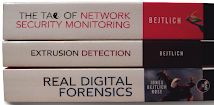TaoSecurity Security Effectiveness Model

After my last few Tweets as @taosecurity on threat-centric vs vulnerability-centric security, I sketched this diagram to help explain my thinking.
Security consists of three areas of interest: 1) What defenders think should be defended, whether or not it matters to the adversary or whether it is in reality defended, what I label "Defensive Plan"; 2) What the adversary thinks matters and really should be defended, but might not be, what I label as "Threat Actions"; and 3) What is in reality defended in the enterprise, whether or not defenders or the adversary cares, what I label "Live Defenses".
I call the Defensive Plan "Correct" when it overlaps with the Adversary Actions, because the defenders correctly assessed the threat's interests. I call it "Incorrect" when Live Defenses are applied to areas outside the interest of the security team or outside the interest of the adversary.
I call the area covered by the Live Defen









